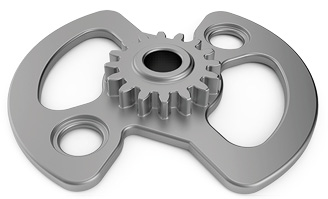Advancing Additive Manufacturing Materials
Latest News
April 1, 2018
For the third year, DE has worked with Senvol to share material providers of industrial additive manufacturing (AM) materials from the Senvol Database. Just between this time in 2016 and now, the number of material providers has grown by 186% and the number of materials in their database has grown by 204%. That rate of growth has left many design engineering teams racing to keep up with the best materials for their applications.
 Nylon and stainless steel (shown here) are two of the most popular 3D printing materials. Image courtesy of Proto Labs.
Nylon and stainless steel (shown here) are two of the most popular 3D printing materials. Image courtesy of Proto Labs.Some applications, such as those in medical and aerospace, require specialized materials, not only to meet exacting specifications but to satisfy regulatory requirements and certifications. To those ends, some manufacturers are working on their own proprietary 3D printing/AM materials or working directly with material providers.
“Materials don’t stand alone,” says Chuck Alexander, director of Product Management at Stratasys Direct Manufacturing. “Materials go with process and application. All aspects need to work together to deliver a reliable repeatable result.”
Alexander says part of Stratasys Direct Manufacturing’s 3D printing and advanced manufacturing services includes engaging with customers to develop processes for specific high-value applications—such as sensor housings for “down the hole” oil & gas industry drilling that have to resist corrosion or rocket nozzles with good thermal conductivity.
However, the majority of design engineering teams aren’t as specialized. They value familiarity and versatility when choosing a material. “Probably unsurprisingly, the most in-demand materials are the general purpose ones,” says Eric Utley, applications engineer, Proto Labs. “Specifically, metals and plastics that are well-rounded in mechanical properties and can fill a wide range of uses. PA 12 nylon in plastic printing and 316L stainless steel in metal printing are extremely versatile and are among our most popular materials. Both are moderately stiff and flexible and fit the bill for a wide range of applications.”
The Possibilities are Not Endless
The right materials, married to the right AM process, can yield impressive 3D printing results that aren’t viable for traditional manufacturing. However, after years of being touted as enabling design complexity with very little trade-offs, industrial users of 3D printing now understand there are limits to what AM can efficiently and economically do.
“For example, if a part has fine channels snaking through the interior and needs to be clear, the only real option to 3D print the part is via stereolithography,” Utley says. “Usually the biggest factor is if the geometry requires supports or is at risk of warping during the build. An organic shape like an oak tree would be virtually impossible in a 3D printing technology that requires supports and would be better suited to be built in a support-less tech like SLS (selective laser sintering) or HP’s Multi Jet. Typically, stiffer materials fare better against material warping, so if a part has thin walls or is otherwise at high risk for warp we may recommend going with a stiffer material to compensate.”
When working with a material and/or part provider, design engineering teams need to communicate their application requirements, Alexander says. For early prototypes, the material choice may be less important than cost and speed factors. When creating parts for testing, certain functional requirements will come to the fore. For production AM, quality certifications and controls help determine the material and process.
“The devil is always in the details,” he says. “It all starts with the application.”
Getting Real
Addressing the realities of AM design constraints, processes and materials is helping to advance industrial additive manufacturing. More engineers are becoming accustomed to designing for 3D printing and AM design software is becoming more robust.
“It’s an exciting time out there,” Alexander says. “New processes and materials are becoming available all the time. It’s been a great thing for the market—all that competition.”
More Info
Subscribe to our FREE magazine, FREE email newsletters or both!
Latest News
About the Author
Jamie Gooch is the former editorial director of Digital Engineering.
Follow DE





